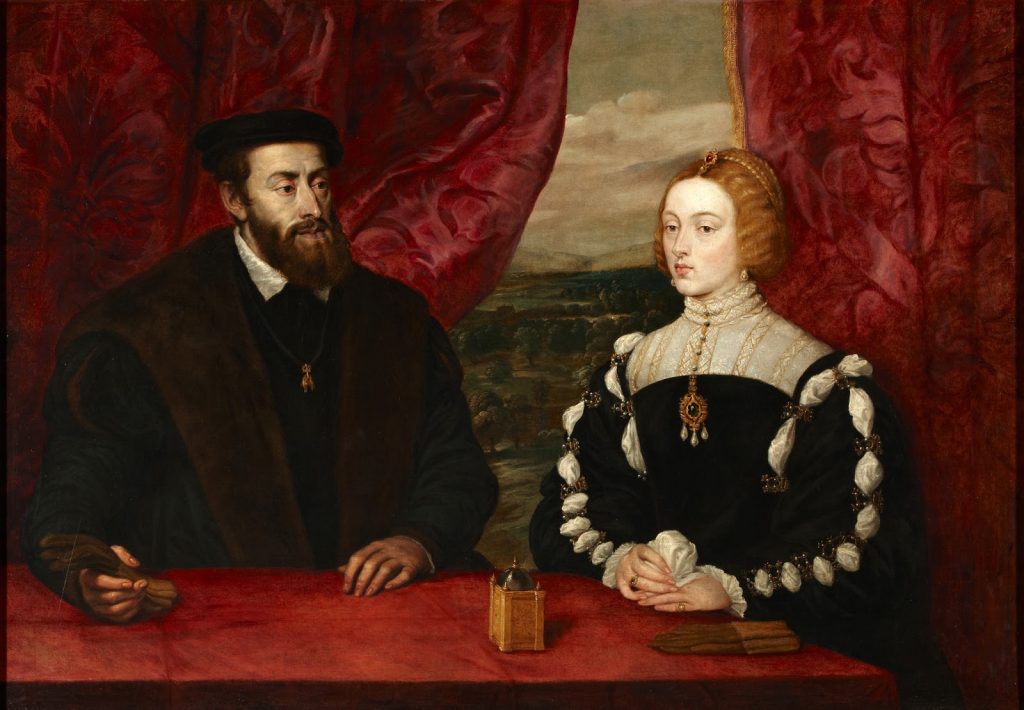Week 14
Charles V (1500 – 1558) was Holy Roman Emperor and Archduke of Austria from 1519 to 1556, King of Spain (Castile and Aragon) from 1516 to 1556, and Lord of the Netherlands as titular Duke of Burgundy from 1506 to 1555. As he was head of the rising House of Habsburg during the first half of the 16th century, his dominions in Europe included the Holy Roman Empire, extending from Germany to northern Italy with direct rule over the Austrian hereditary lands and the Burgundian Low Countries, and a unified Spain with its southern Italian kingdoms of Naples, Sicily, and Sardinia. Furthermore, his reign encompassed both the long-lasting Spanish and the short-lived German colonizations of the Americas. The personal union of the European and American territories of Charles V was the first collection of realms labelled "the empire on which the Sun never sets". Charles was born in the County of Flanders to Philip the Handsome of the Austrian House of Habsburg (son of Maximilian I, Holy Roman Emperor, and Mary of Burgundy) and Joanna the of the Spanish House of Trastámara (daughter of Isabella I of Castile and Ferdinand II of Aragon). The ultimate heir of his four grandparents, he inherited all of his family dominions at a young age, due to the premature death of his father and the mental illness of his mother. After the death of Philip in 1506, he inherited the Burgundian Netherlands, originally held by his paternal grandmother Mary. In 1516, he became co-monarch of Spain with his mother Joanna, and as such he was the first king of Spain to inherit the country as dynastically unified by the Catholic Monarchs, his maternal grandparents. The Spanish possessions at his accession also included the Castilian West Indies and the Aragonese Kingdoms of Naples, Sicily and Sardinia. At the death of his paternal grandfather Maximilian in 1519, he inherited Austria and was elected to succeed him as Holy Roman Emperor. He adopted the Imperial name of Charles V as his main title, and styled himself as a new Charlemagne. See below a portrait of Charles with his Portuguese bride Isabella. Their son Philip II will inherit the whole of the Iberian peninsula for the first time in history.
REQUIRED READING

Steven Ozment,
A Mighty Fortress: A New History of the German People,
Harper Perennial,
ISBN 0060934832
RECOMMENDED READING
Institute Library Call Number: 942.031 Par EMP

James Bryce,
The Holy Roman Empire,
CreateSpace Independent Publishing Platform (September 12, 2012) ,
ISBN 1479208523
The Holy Roman Empire was, according to Voltaire, neither holy, nor Roman, nor an empire. But it was long-lived, complex, brutal, important, and fascinating, as is evident from the reading of this notable work published in 1871 by the English jurist, historian and politician, James Bryce (1838 to 1922). Bryce concentrates his considerable erudition on the meaning and significance of the empire’s existence rather than on its chronology. This is an essential work for the understanding of western history.
Reader comments on Amazon:
By Lisa C. Philip on July 8, 2013 Format: Paperback." Even though this book was written over one hundred years ago it is still the best book on the topic. Packed with so much information. Highly recommended for anyone interested in the topic."
Institute Library Call Number: 943 943 Bry HOL



